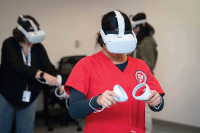The cost of healthcare in the United States re-mains a top priority for all Americans. One way the American Nurses Association (ANA) helps determine resource expenditure and provider reimbursement—including reimbursement for advanced practice registered nurses (APRNs) who directly bill Medicare and resource expenditures for nursing services—is through participation in the work of the American Medical Association’s Relative-Value Scale Update Committee (RUC).
The RUC is a volunteer expert panel composed of 31 physicians and qualified healthcare professionals and 300 specialty advisors who represent every facet of healthcare today. ANA holds a seat on the RUC through the Health Care Professionals Advisory Committee (HCPAC) and has a member representative on the Practice Expense Subcommittee (PE subcommittee).
RUC committee members and volunteers meet three times a year to evaluate current procedural terminology (CPT) codes identified for review by the Centers for Medicare and Medicaid Services (CMS), as well as those submitted by healthcare specialty organizations and other healthcare stakeholders. The RUC process takes into account provider and nursing time, supplies, and equipment for billable work and makes recommendations to CMS.
Before each RUC meeting, participating organizations indicate their desire to take part in the valuation process of codes identified for review. Each organization, including ANA, completes a Level of Interest form indicating how they will participate in the presentation of codes identified for review in an upcoming RUC meeting. Surveys regarding the codes to be presented are circulated to qualified healthcare professionals who perform those services and the results are used in the valuation of each code. Input by ANA and its members provides critical information about APRN and RN work described in a code. Completing these surveys and participating in the presentation of codes under review ultimately improves or preserves reimbursement for nurses and highlights their value in healthcare.
An integral part of the RUC schema is input from committees within the RUC process that provide re-view recommendations. One such committee is the RUC HCPAC. The HCPAC is a nonphysician commit-tee made up of 12 organizations (ANA represents all nursing specialties) that includes nurses, physician assistants, chiropractors, occupational therapists, optometrists, physical therapists, podiatrists, psychologists, audiologists, speech pathologists, social workers, and registered dieticians. The committee evaluates codes germane to the HCPAC and then makes relative-value recommendations to the full RUC and CMS.
Since virtually every code presented to the RUC includes nursing work, input from ANA’s RUC representative is a vital part of the process. In many cases, the codes presented for review and valuation are billed by APRNs. Each part of these codes—and ultimately the reimbursement recommendations to CMS—largely depends on an accurate accounting by nursing professionals in this part of the RUC process. Nurses at all levels directly contribute to valuation of these codes by completing surveys sent out by ANA to nursing professionals who perform these medical, surgical, and diagnostic procedures and services in a clinical setting.
Another important aspect to the RUC process is the PE subcommittee. According to a recent analysis by the RAND Corporation, practice expense accounts for 45% of the total Medicare physician fee schedule payments. The PE subcommittee evaluates and re-views practice expense inputs for each code present-ed at the RUC. Since each code presented typically has nursing staff work included, input from nursing professionals is essential. The ANA representative to the PE subcommittee is an invaluable participant in this process by advising the subcommittee and the RUC on nursing issues related to the reviewed codes.
Participation in the review, revision, and presentation process of codes by all nursing professionals in sup-port of ANA should be enhanced. Nurses should en-gage with the RUC process through ANA and its RUC advisors on the HCPAC and the PE subcommittee to best illustrate the value of the work nurses do every day. Appropriate monetary valuations of these codes directly reflect nurses’ central role in the provision of healthcare and ultimately drive autonomy and salaries.
The work of the RUC recently resulted in a significant upward re-valuation of evaluation and management codes—for which APRNs are high-volume providers—beginning in calendar year 2021. Understanding the RUC process, by learning more about what comprises CPT codes and how they are valued, helps the nursing profession demonstrate its relative value in healthcare. Critically analyzing nursing work and its relative value in every area of practice allows nurses to contribute in this incredible process. For more in-formation about the RUC process visit ama-assn.org/go/rbrvs.
— W. Bryan Sims is the director of clinical practice for nurse practitioners and physician assistants at the Bandera Family Practice Clinic in Bandera, Texas, and a Texas Nurses Association member. Sims was ANA’s RUC Advisor and Practice Expense Subcommittee representative from 2010 to 2019.
Resources
American Medical Association. RVS Update Process AMA/Specialty Society. 2019.
Burgette LF, Liu JL, Miller BM, et al. Practice Ex-pense Methodology and Data Collection Research and Analysis. 2018. RAND Corporation: Santa Moni-ca, CA. rand.org/content/dam/rand/pubs/research_reports/RR2100/RR2166/RAND_RR2166.pdf
American Medical Association. RVS Update Com-mittee (RUC). ama-assn.org/about/rvs-update-committee-ruc/rvs-update-committee-rucADVOCACY




















